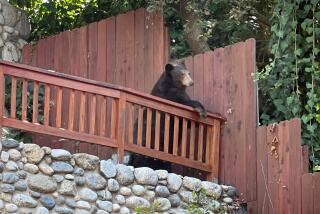Wild pigs are wearing out their welcome in San Diego County
- Share via
Reporting from San Diego — They’re big, ugly and mean.
Nobody is 100% sure where they came from, but the feral pig population in the woodsy region of eastern San Diego County is expanding.
Without natural predators, and with a proclivity for reproduction, the wild pigs number several hundred. An average adult can range from 200 to 300 pounds, with nasty-looking tusks and a frightening snort.
Biologists say they are a menace to the bird population and they nibble on new-growth trees, not a good thing in those areas struggling to recover from wildfires. There has even been a report of several pigs, snorting and wiggling their tusks, chasing a backcountry bicyclist up a tree.
So the federal government is considering an eradication plan: traps and maybe hunting. Pig-hunting is already legal, but the feds may hire professionals, using dogs and helicopters.
As newcomers to the region, the pigs and their foraging habits are seen as a threat to the native deer, as well as turkey and other ground-nesting bird populations.
The pigs also like to dine on acorns. The coast live acorn and the black oak acorn are already being hit by changes in weather and the gold-spotted oak borer, officials note.
“Further stress caused by pigs could present a significant problem in oak habitats in the Cleveland National Forest,” said William Metz, forest supervisor.
The Forest Service has published a proposed eradication plan. The public has until the end of the month to comment. A public hearing may also be held.
People for the Ethical Treatment of Animals opposes killing the pigs, particularly if hunting from helicopters is employed. PETA calls aerial hunting “crueler than cruel” because it reportedly leaves many animals wounded and condemned to a slow, painful death.
“The feral pigs are there through no fault of their own,” said Martin Mersereau, PETA’s director of cruelty investigations. “They’re just trying to feed their families.”
The Barona band of Mission Indians and the Viejas band of Kumeyaay Indians, which have large land holdings in rural eastern San Diego County, take a different view.
One rumor — like a lot of information about the feral pigs, it is unconfirmed — is that the feral pigs are descendents of a failed venture to start a game-hunting ranch on Indian property. Another explanation is that the pigs migrated from Mexico or from other states where colonies have long been established.
As sovereign nations, the tribes can do what they want on their own property. But tribal officials are discussing a regional solution with state and federal wildlife officials because pigs do not obey boundaries.
“We want those little biological time bombs eliminated if possible,” said Viejas spokesman Bob Scheid.
San Diego County is not alone in confronting feral pigs. By one estimate, 56 of the state’s 58 counties have feral pigs.
In Oregon, farmers are complaining about the pigs rooting up their crops. In Washington, farmers are worried that the pigs will cross the border from Oregon, perhaps when migrating from California. A new law in Oregon requires landowners to trap or shoot the pigs on their own property to prevent damage to their neighbors.
The New Mexico Fish and Game Department held a summit meeting last month to plot pig strategies. One state legislator said the pigs have gotten so bold that they walk into towns looking for food, scaring residents.
The feral pig population in Texas may be the biggest in the nation, with freeway billboards offering the services of pig hunters. In Georgia, a hunter killed a feral pig so big he named it Hogzilla.
In Michigan, an order effective next month declares the feral pigs an invasive species, to the chagrin of rock musician and game-farm owner Ted Nugent. He says that the pigs have gotten a bad rap and that officials are overestimating their numbers and the damage they cause.
In San Diego, officials hope to act before the feral pig population gets bigger and more unruly.
But even if the eradication plan is adopted, reducing the pig population will not be easy, as hunters will tell you. The pigs are largely nocturnal and highly mobile and have keenly developed survival skills.
And, of course, all it takes is one frisky boar and a fecund sow to start the cycle anew.
“Even if all the pigs were to be removed, the potential for wild pigs repopulating the area remains,” Metz said.
More to Read
Sign up for Essential California
The most important California stories and recommendations in your inbox every morning.
You may occasionally receive promotional content from the Los Angeles Times.










